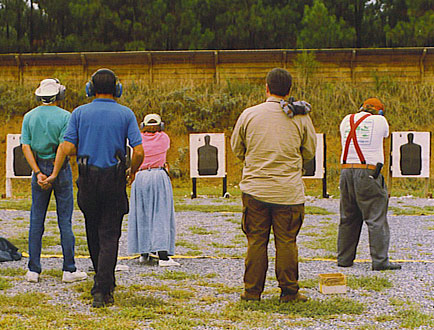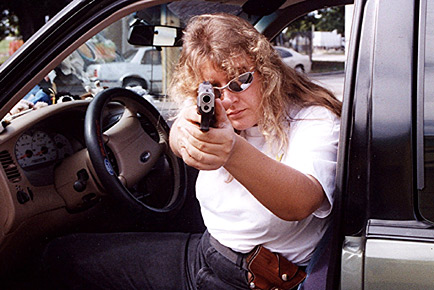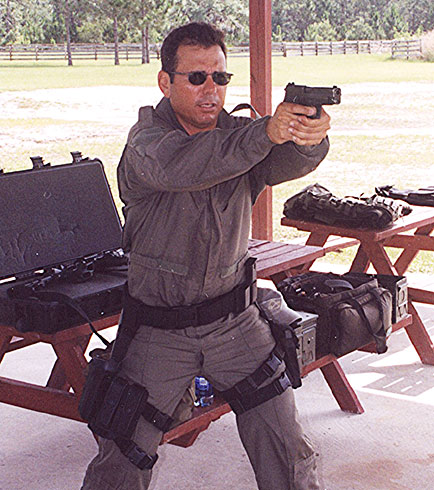
"Pistols are a trade off - trading range and accuracy for Portability and Concealability. The method of shooting - instinctive fire, most shooting is based on methods used in target shooting - steering at the front sight. Close range gun fighting is a world away from target shooting."
Retired CSM Eric Haney / author and founding member of Delta Force from "Inside Delta Force, The Story of America's Elite Counter Terrorists Unit". This article started out as a letter to an Editor of another gun magazine, who rebuked a writer supporting the Isosceles stance over the classic Weaver stance. It appeared the Editor did not care for the Isosceles stance.
I phoned this Editor and personally asked him the extent of his background, had he ever been a military, law enforcement, or civilian who had been in an actual gunfight? He promptly said, "No," and rudely hung up the phone on me. More recently I attended a seminar, once again the instructor was teaching the "Weaver's stance," to a group of seasoned Law Enforcement officers who were instructors from their own individual departments, again the question was asked to this instructor,"Are you or have you ever been a Law Enforcement officer?" Again the answer was, "No." Then my first question is to this instructor, "What in the hell are you doing teaching seasoned cops firearms training, especially if you have never been one?"
Time and time again we're finding out what works well for "target shooting," on a nice sunny range in no way, shape, form, has anything to do with tactical combat firearms situations. So I thought I would once again address this ongoing debate from a slightly different angle.
Since I've studied animal/human behavior, (in which I have a Master's degree)added to the fact that I have been a police officer, I feel I've earned the right to add my two-cents to the subject, so here it goes.

Addressing the subject of the classic Weaver Stance versus the Isosceles goes beyond learned mechanical natural or instinctive natural reaction under stress. The reasons for the ongoing debate is no one breaks down the categories of the person who is doing the shooting, in what role the person is playing when shooting, the history and origins of each shooting style, and if the shooting is done at paper targets, or at live human beings.
First, the history of what is now known as Basic Pistol and Rifle Marksmanship, the genesis of this program came from the military. The steady hold factors, proper breathing, front sight/rear sight alignment, and squeezing not pulling (or jerking)the trigger, all came from military precision marksmanship training. This is exactly the type of trained discipline one needs to have when participating in competitive shooting events. After all, the goal of any serious shooter is to become a distinguished shooter with an expert rating.
The military, seen as a definitive authority on the subject of marksmanship, later shares their expertise with Federal and Local Law Enforcement, who adapted the same guidelines, policies, and procedures with regards to marksmanship. The misnomer here is marksmanship is often misunderstood for tactical shooting, a common mistake, since it is automatically assumed that military and law enforcement personnel are going to have the most combat experience.
While the Weaver's origin was created in good faith as practical simulated combat competition, the bottom line is, it was just that, simulated combat competition, with respect to the original Founders of IPSC, who were doing everything they could to emphasize proper tactical training. The one thing that just could not be replicated at the time was someone shooting back at the shooter. What was practical, and preached by the founding fathers of IPSC, soon became the gospel, and when people are bound by tradition, then who will argue the abolition of a particular style, especially when the founding fathers take the legendary status in the world as Literary Authors? How dare upstarts alter this tradition, faithfully passed down from generation to generation by venerated masters who tolerate only modest changes?
Let's define the shooter's, they fall into one of the following categories A) Service member. B) Police Officer C) Civilian D) Bad guy. All of the above can participate in both precision marksmanship shooting skills and combat shooting skills, what will separate the categories is the roll each will play in a "Predator versus Prey role."

If in the course of their required duties as either "Military or Police" role, (looking for the bad guy) then the police and military are in essence playing the predator's role and the bad guy would be by definition the prey. If the military or police having command authority, utilizing more manpower, superior tactics without any shots fired when taking the bad guy into custody ,one might see a classic weaver pose, because that is what muscle memory has been programmed to do, however if the role is reversed, and the bad guy now ambushes the military or law Enforcement personnel, the natural bodies reaction will take over, not through a learned response, but an instinctive response, through the autonomic nervous system.
In the fight-or-flight situation, or an emergency, the body will instinctively react to a spontaneous and unexpected crouch, the next instinctive reaction is to subconsciously push away from the danger by creating distance, if one is armed, he or she will create distance by protruding their fire arm to full arm's extension, which, I believe, is called the Isosceles stance. This is the same thing a civilian will do when reacting to a critical crisis situation. The pundits of the weaver stance are bound by tradition, and do not wish to accept the fact that the overwhelming statistics state under stress will support the Isosceles stance.
This has been the case as far back as 1910 which was reported by Fairbairn and Sykes, and later discussed by Colonel Rex Applegate in 1943, in 1961 by the FBI Firearms Academy, and supported by modern pundits like Bruce Siddle, Michael Janich, Ralph Mroz, and Massad Ayoob.

We now have the benefit of modern technology, through the wonderful world of video; everyone with a television has had the opportunity to see actual live gunfights, right before their eyes, when bullets are exchanged. I have yet to see anyone respond to gunfire in a classic weaver stance; while on the other side of the argument I have personally witnessed, in live situations, people automatically reverting to isosceles when there is an exchange of gunfire.
The advocates of the Weaver stance state it is for better stance if one is wearing tactical body armor, my response to that is nonsense. If one watches closely every Elite Hostage Rescue Unit, Delta, Seal team 6, FBI, HRT, SAS, GSG-9, Spetznaz, OMON, LAPD, Orlando, NYPD SWAT; all are wearing hard body armor and load bearing vests, and on all live entries, perform isosceles shooting techniques without any problems. Furthermore, through my own personal experience, I can assure you no one knows better of the complexities of wearing a load bearing body armored vest, for as a tactical police officer I wore one for over five years, while working in Narcotics and SWAT. Under stress I still used the isosceles stance when going through a building door, and I have a bigger disadvantage than most, I didn't have the advantage of having a custom-made vest, since our department had only one other female officer they didn't feel the justification for the added expense.
Another argument - the proponents of the weaver stance state it is bio-mechanically stronger, thus making it better for range work. Maybe, but the last time I checked, shooters like Rob Leathem, Jerry Barnhart, Chip McCormick, J. Michael Plaxco, and Frank Garcia all shoot in an isosceles stance. Though the above mentioned men aren't law enforcement or military, they all are great pistol champions nonetheless. I've seen both photos and videos of Dale Comstock and Gene Zinc demonstrating shooting stances, it sure looks like an isosceles stance to me, and both are Ex-Army Delta Force Operators. One of your country's top law enforcement legends, because he has been in so many gunfights, is Jim Cirillo - how does he shoot and what does he teach? Isosceles.
So what are actual gun fight statistics telling us? No, screaming at us!
1. Most armed conflicts occur at arm's length - rather than 15 to 25 yards
2. Standard military or police marksmanship rules are not necessary at this range, i.e. front sight, rear sight, perfect site picture, breathe and squeeze the trigger, those rules will not apply in a gunfight, and that's not theory, its experience.
In one of my favorite American family movies, John Wayne's last and perhaps best movie, "The Shootist," he has a dialogue with his character (J. B. Books) and Gilliam (played by Ron Howard). When the two of them go shooting together they have similar groups on the target. Gilliam asked the Shootist, J. B. Books, "How could you get in so many fights and always come out on top --I nearly tied you?" The Shootist responds, "Friend, there's nobody shooting back at you." That's one that Hollywood got right! So why aren't we training with firearms like actual gunfights?